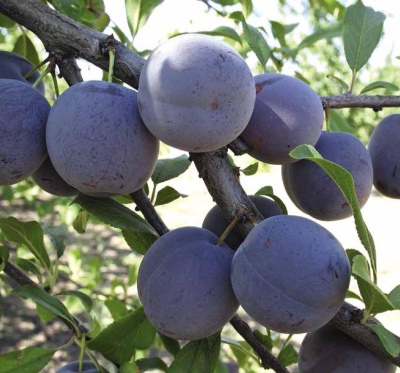
- Authors: L.I. Taranenko (Donetsk branch of the Institute of Horticulture UAAS)
- Growth type: vigorous
- Crown: thick
- Fruit size: large
- Fruit weight, g: 35-40
- Fruit shape: correct, rounded
- Fruit color: Red
- Skin : dense
- Pulp (consistency): medium density, juicy
- Pulp color : dark yellow
Homemade plum Renklod Karbysheva bred by Ukrainian breeders, is very popular in the south of Russia and in the CIS countries. The variety is considered one of the most delicious among early ripening varieties, perfect for processing or eating fresh fruits. These plums are especially good in dried and dried form.
Breeding history
Ranklode Karbyshev was obtained by crossing the parent plants Jefferson and Peach. The selection work was carried out by L. I. Taranenko, a specialist of the Donetsk branch of the Institute of Horticulture of the UAAS. Not marked in Russian registers.
Description of the variety
The tree is vigorous, with a dense spherical crown. Both annual shoots and other parts of the crown - spurs, bouquet twigs are considered fruitful. It can grow in bush form, in the standard form it reaches 4-6 m, well suited for use as a rootstock for cherry plum, apricots, and other plums. Renklod Karbyshev propagates by grafting on more frost-resistant bases.
Fruit characteristics
Plum for universal use, transportable. Fruits are large, weighing 35-40 g, regular round shape. The skin is red, dense, with a dark yellow flesh inside. The stone separates well from the pulp and is of medium size.
Taste qualities
Plums of this variety are sweet, with a spicy light sourness, juicy. The aroma is pleasant, characteristic of this type of fruit tree. The tasting score is very high, 4.9 points.
Ripening and fruiting
Plums are harvested in early August. The first flowering and fruiting occurs at 3-4, in a young shoot from old roots at 6-7 years.

Yield
Depends on the presence of pollinators. Usually high. At the age of about 25 years, fees can reach 100 kg per tree, but the average figures do not exceed 30 kg.
Growing regions
The variety is thermophilic. In Russia, it is more often cultivated in the latitudes of the Krasnodar Territory. But there is also an experience of its successful cultivation in the conditions of the Moscow region, the Leningrad region.
Self-fertility and the need for pollinators
The variety is self-fertile. Does not produce ovaries without pollinating varieties in the garden. For these purposes, you can plant Hungarian Donetsk and other varieties that coincide with Karbyshev's Renklod in terms of flowering time.
Growing and care
Plants definitely need a sufficient amount of sunlight. The soil is recommended to be breathable, preferably loam or sandy loam with neutral or weak acidity. Plants must not be planted on stony or clayey soils. It is customary to retreat 4-5 m from neighboring plants, buildings, structures.
It is better to cook holes in the fall. Their depth is made up to 60 cm, diameter up to 70 cm. Potassium and humus are added to the removed soil. Then 2 pegs are put down, the cutting is supported on them, sprinkled with soil substrate.
Plant care also has its own characteristics.Renklod Karbyshev in the period before harvest can be prone to fracture of branches. In this case, special props are used for it.
In early spring, after leafing out or early June, annual pruning is done. In the 1st year, 10 skeletal branches are left to form the crown with equal intervals between them. The branches should extend from the central trunk at a 45 degree angle. In the 2nd year, all formed growths are removed up to a length of 25 cm. A three-year-old tree will only need to shorten the shoots at the base of the crown to 300 mm, the rest are cut to 150 mm.
Fertilizing the plant is necessary from the age of three. In April, the plum is fertilized for the first time; you can use ammonium nitrate with potassium salt. During flowering, the tree will benefit from a urea solution. After him - a mixture of superphosphate, mullein solution. At the stage of fruit ripening, mineral complexes and foliar feeding with a solution of urea in a concentration of 1% are used.
Watering is carried out using holes at a depth of 35-40 cm. The water is taken from settled, warm. Such manipulations are required 5-6 times during the season. A tree takes 4 to 8 buckets of water.




Disease and pest resistance
Plum of this variety is considered to be moderately resistant to diseases and pests. It is strongly affected by secondary moniliosis, requires regular treatment for this disease.

Despite the fact that plum is considered more hardy than many fruit trees, it is not immune from diseases. It is attacked by viral, fungal and bacterial infections, and parasitic insects harm it. It is necessary to notice and recognize the signs of plum disease in time. They are easier to deal with and defeat early on. Well, in order to protect the garden tree from such a misfortune in the future, preventive procedures can be carried out.
Resistance to soil and climatic conditions
The variety has an average winter hardiness. Sensitive to drought, poorly tolerated by lack of watering.

Review overview
Gardeners give Renkloda Karbyshev extremely high marks. It is noted that wonderful jams, preserves, compotes are obtained from its fruits. Summer residents also actively use the fruits for the preparation of barbecue marinade. It is noted that the plants bloom together, but difficulties may arise with the formation of ovaries.But in most areas, pollination occurs without outside interference if there are at least 2 trees.
The owners of this variety of plums note that the taste of the plum changes during hot seasons. With a lack of moisture, plants lose a significant proportion of the juiciness of their fruits.


































































